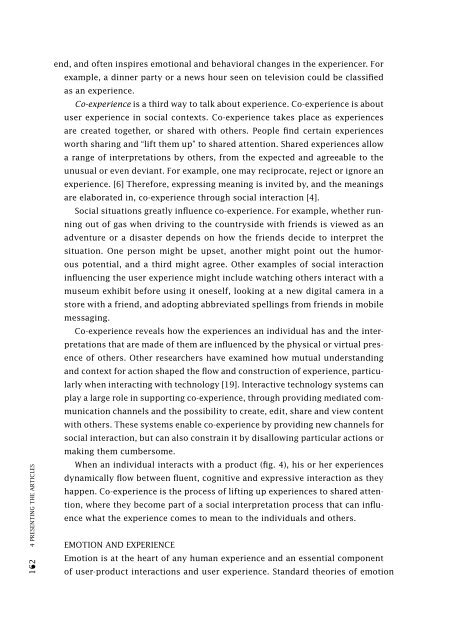Co-experience: Understanding user experiences in social interaction
Co-experience: Understanding user experiences in social interaction
Co-experience: Understanding user experiences in social interaction
You also want an ePaper? Increase the reach of your titles
YUMPU automatically turns print PDFs into web optimized ePapers that Google loves.
162 4 PRESENTING THE ARTICLES<br />
end, and often <strong>in</strong>spires emotional and behavioral changes <strong>in</strong> the <strong>experience</strong>r. For<br />
example, a d<strong>in</strong>ner party or a news hour seen on television could be classified<br />
as an <strong>experience</strong>.<br />
<strong>Co</strong>-<strong>experience</strong> is a third way to talk about <strong>experience</strong>. <strong>Co</strong>-<strong>experience</strong> is about<br />
<strong>user</strong> <strong>experience</strong> <strong>in</strong> <strong>social</strong> contexts. <strong>Co</strong>-<strong>experience</strong> takes place as <strong>experience</strong>s<br />
are created together, or shared with others. People f<strong>in</strong>d certa<strong>in</strong> <strong>experience</strong>s<br />
worth shar<strong>in</strong>g and “lift them up” to shared attention. Shared <strong>experience</strong>s allow<br />
a range of <strong>in</strong>terpretations by others, from the expected and agreeable to the<br />
unusual or even deviant. For example, one may reciprocate, reject or ignore an<br />
<strong>experience</strong>. [6] Therefore, express<strong>in</strong>g mean<strong>in</strong>g is <strong>in</strong>vited by, and the mean<strong>in</strong>gs<br />
are elaborated <strong>in</strong>, co-<strong>experience</strong> through <strong>social</strong> <strong>in</strong>teraction [4].<br />
Social situations greatly <strong>in</strong>fluence co-<strong>experience</strong>. For example, whether runn<strong>in</strong>g<br />
out of gas when driv<strong>in</strong>g to the countryside with friends is viewed as an<br />
adventure or a disaster depends on how the friends decide to <strong>in</strong>terpret the<br />
situation. One person might be upset, another might po<strong>in</strong>t out the humorous<br />
potential, and a third might agree. Other examples of <strong>social</strong> <strong>in</strong>teraction<br />
<strong>in</strong>fluenc<strong>in</strong>g the <strong>user</strong> <strong>experience</strong> might <strong>in</strong>clude watch<strong>in</strong>g others <strong>in</strong>teract with a<br />
museum exhibit before us<strong>in</strong>g it oneself, look<strong>in</strong>g at a new digital camera <strong>in</strong> a<br />
store with a friend, and adopt<strong>in</strong>g abbreviated spell<strong>in</strong>gs from friends <strong>in</strong> mobile<br />
messag<strong>in</strong>g.<br />
<strong>Co</strong>-<strong>experience</strong> reveals how the <strong>experience</strong>s an <strong>in</strong>dividual has and the <strong>in</strong>terpretations<br />
that are made of them are <strong>in</strong>fluenced by the physical or virtual presence<br />
of others. Other researchers have exam<strong>in</strong>ed how mutual understand<strong>in</strong>g<br />
and context for action shaped the flow and construction of <strong>experience</strong>, particularly<br />
when <strong>in</strong>teract<strong>in</strong>g with technology [19]. Interactive technology systems can<br />
play a large role <strong>in</strong> support<strong>in</strong>g co-<strong>experience</strong>, through provid<strong>in</strong>g mediated communication<br />
channels and the possibility to create, edit, share and view content<br />
with others. These systems enable co-<strong>experience</strong> by provid<strong>in</strong>g new channels for<br />
<strong>social</strong> <strong>in</strong>teraction, but can also constra<strong>in</strong> it by disallow<strong>in</strong>g particular actions or<br />
mak<strong>in</strong>g them cumbersome.<br />
When an <strong>in</strong>dividual <strong>in</strong>teracts with a product (fig. 4), his or her <strong>experience</strong>s<br />
dynamically flow between fluent, cognitive and expressive <strong>in</strong>teraction as they<br />
happen. <strong>Co</strong>-<strong>experience</strong> is the process of lift<strong>in</strong>g up <strong>experience</strong>s to shared attention,<br />
where they become part of a <strong>social</strong> <strong>in</strong>terpretation process that can <strong>in</strong>fluence<br />
what the <strong>experience</strong> comes to mean to the <strong>in</strong>dividuals and others.<br />
EMOTION AND EXPERIENCE<br />
Emotion is at the heart of any human <strong>experience</strong> and an essential component<br />
of <strong>user</strong>-product <strong>in</strong>teractions and <strong>user</strong> <strong>experience</strong>. Standard theories of emotion

















